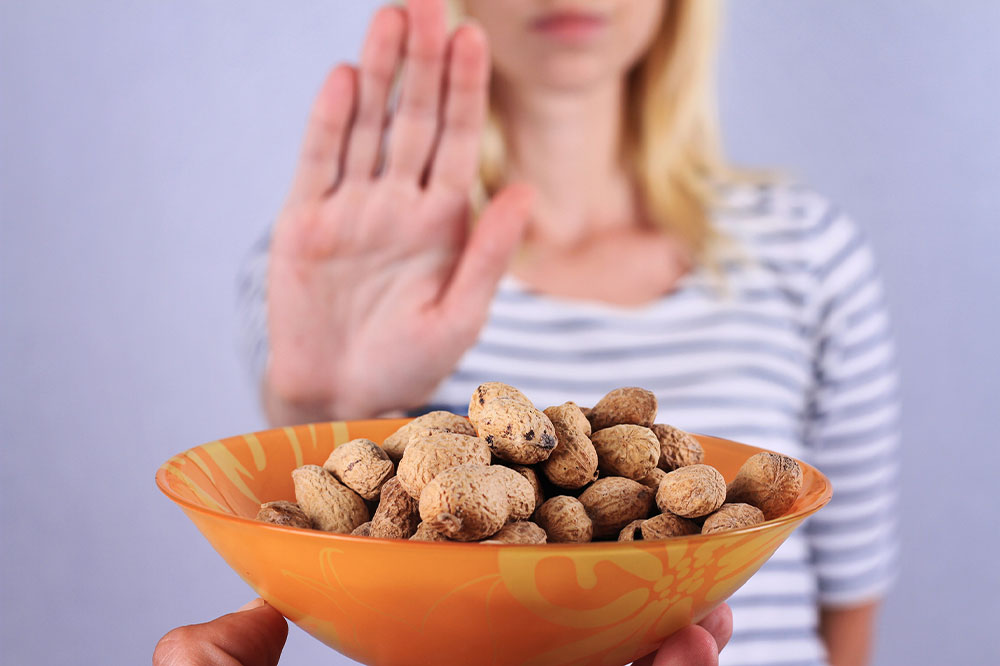
Simple healthy changes to manage and treat peanut allergies
Peanut allergy ranks among one of the most common types of food allergies in the country known to affect children and adults. In fact, kids can develop a peanut allergy from a young age. There is no cure yet, but the condition and its symptoms can be managed to improve quality of life. Simple changes in food regime and medications, and immunotherapy treatment can help manage the allergy. Read to know more.
Foods to eat
- Meats for protein
Eliminating peanuts completely from your food regime can be challenging, especially if the allergy is new. However, there are several viable substitutes that pack a punch of protein. Lean cuts of turkey, chicken, tuna and some red meats like pork or beef are foods that can be safely consumed. - Grains, pulses, and seeds
Brown rice, cornflour, millets, barley, wild rice, Kamut, wheat, pelt, sesame seeds, and sunflowers seeds are quite safe to include in your daily meals. These grains are packed with niacin or soluble vitamins, mainly vitamin B3 that helps the body convert food into energy and promotes better digestion. - Some tree nuts
Studies show that not all people who are allergic to peanuts are also allergic to tree nuts. Popular options like almonds, walnuts, Brazil nuts are safe to eat. However, it is advisable to consult with the physician or nutritionist to understand safe long-term consumption. - Alternative cooking techniques
Food can taste good with substitutes like almond butter, sunflower seed butter, coconut butter, watermelon seed butter, and tahini. Beans can be a great substitute for recipes that feature peanuts as the main ingredient. One can add roasted chickpeas and soybeans to salads to get that crunch of peanuts minus the allergy symptoms. - Peanut free snacks
Since children are more likely to suffer from peanut allergies, one can consider these alternative snacks to satiate those hunger pangs. Popcorn, celery sticks with dip, oatmeal cookies, waffles, vegetables with dip, and pretzels are popular food to eat. Fresh fruit platters can also make up for a decent snack platter in case kids are not happy with the choice of veggies.
Foods to avoid
- Peanut ingredients
No doubt one must avoid whole peanuts in any form. But even foods that contain peanut butter, peanut flour, peanut starch, or peanut powder should be eliminated from daily foods. Unfortunately, a number of processed foods bought off the shelves in the supermarket are made primarily using these ingredients, so the list is quite exhaustive. - Different types of sauce
Chili, enchilada sauce, glazes, marinades, hot sauce, pesto, gravy, guacamole sauce, and salad dressing may contain peanut-based ingredients. Even light contact can trigger a severe allergic reaction that results in swelling. - Sweets
Praline, pastries, goobers, nougat, marzipan, cookies, pudding, baked confectionaries, pies, chocolate, and different types of candies may contain nuts, seeds, or a nut-based ingredient that can flare-up a peanut allergy. - Assorted nuts and grains
A peanut allergy is not necessarily triggered due to peanuts. Foods that contain nut ingredients, including beer nuts, Mancelona, monkey nuts, nut meat, must be eliminated to avoid flareups. Also, grains found in muesli cereal or used to make granola bars can contain traces of peanut products to add flavor. - Cuisines that feature peanuts
Even if the dish itself doesn’t contain peanuts, there is a good chance of cross-contact. Popular cooking styles including Chinese, Indian, Vietnamese, Indonesian, Thai, African, and Mexican incorporate assorted nuts that can trigger common food allergies.
It is necessary to read food labels and understand the ingredients before consumption. Most store-bought items can contain some form of peanut-based ingredient, and it may not be listed as a primary ingredient. But it could be a condiment used to add flavor.
Medications for peanut allergy treatment
Generally, doctors will use an epinephrine autoinjector to counter food-induced anaphylaxis shocks. But this emergency requires a patient to quickly go to the nearest hospital before the symptoms flare-up. The FDA has also most recently approved the following prescription medication as an alternative to peanut allergy immunotherapy treatments.
- Palforzia®
Palforzia® has been approved for use among children between the ages of 4 and 17 with varying degrees of peanut allergy. The medicine should be continued unless otherwise instructed by the doctor. - Antihistamines
Antihistamines can manage some mild to moderate discomforts for a quick home remedy. Readily available over-the-counter medications like Benadryl can help combat some of the symptoms before the body goes into anaphylaxis shock.
Peanut allergy immunotherapy treatments
The main idea behind immunotherapy treatments for allergies is to desensitize the body to the allergen and build up defenses to protect from frequent flare-ups. Doctors expose patients to small quantities of peanut protein and gradually increase the dosage to allow the body to build up a tolerance. There are three different types of peanut allergy immunotherapy treatments.
- Oral Immunotherapy (OIT) involves the patients taking a small dose of peanut proteins as recommended by the doctor.
- Epicutaneous Immunotherapy (EPIT) is a topical solution that involves the use of an adhesive patch applied on the skin. The patch will automatically deliver tiny doses of the proteins to build up a tolerance.
- Sublingual Immunotherapy (SLIT) is another alternative form of administering the medication orally, but using a few drops of the solution instead of the powder.
At the end of the day, if someone has an allergic reaction, do not delay visiting the nearest emergency room. Even if the symptoms are mild and seem to be manageable at home, immediate medical attention is advisable for children and adults.